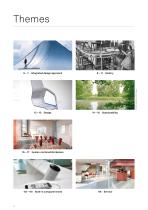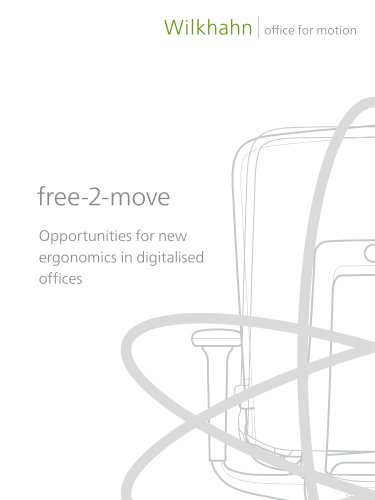 Website:
Wilkhahn
Website:
Wilkhahn
Catalog excerpts

Human-centered Workplace Brand world Nothing’s more constant than change. This fact of life repeatedly presents us with new challenges, but offers new opportunities too. The future’s open to any organization that designs workplaces in new, people-friendly ways. Our goal is to help these employers because we know what we’re talking about. As a more than 100-yearold, family-run company, we’ve seen lots of changes ourselves and shaped them positively. As a result, Wilkhahn is still one of the key trend setters when innovative concepts and products for future- proof working environments are...
Open the catalog to page 5
Photo: Klemens Ortmeyer 6 – 7 Integrated design approach
Open the catalog to page 6
92 – 103 Stand-alone tables and table systems Photo: Deteringdesign GmbH
Open the catalog to page 7
Photo: Klemens Ortmeyer The management building with its floor-to-ceiling windows in the executive offices was completed in 1959. It was the expression of a new corporate culture defined by transparency and team spirit. The idea of incorporating economy, ecology, aesthetics and a people-friendly workplace spawned the four pavilions, which aren’t just architectural gems, but also offer outstanding conditions for the demanding work done by the sewing and upholstery teams. The group of production facilities is visible from afar and stands for the essential qualities of long-lasting product...
Open the catalog to page 9
The 1200 bench system for waiting and transit zones is still encountered in lots of subway stations, 1968 – 1988, design: Friso Kramer. Developments ahead of their time. New developments in materials, technologies, usage concepts and social trends fascinate and empower us to discover what’s missing and make the tried-and-true even better. Timelines of the development milestones over the past 70 years show how ahead of our time we frequently were. The 21A stacking chair by architect, urban planner and designer Roland Rainer was produced between 1958 and 1966. Due to the A-shaped frame made...
Open the catalog to page 11
In production from 1961 to 1998, the 400 laminate range with its characteristic tennis-bat joint became a hit in the form of a lightweight, flexible and comfortable multipurpose chair, design: Wilhelm Ritz. The 232 office chair range, design: Wilhelm Ritz, with its integrated, flexible backrest, became a best seller in its segment and was sold from 1971 to 1990. Today, it’s considered a sought-after collector’s item. The futuristic design of the 238 range (1976 – 1985) by Delta-Design was impressive, particularly in the Bond movie Moonraker. And it was an important step towards developing...
Open the catalog to page 12
The FS-Line, developed by Klaus Franck and Werner Sauer, has been making furniture history since 1980. It made healthy, dynamic sitting the new standard for office chairs worldwide – the easy-to-use, robust and understated classic is probably the most sustainable office chair today and more contemporary than ever. Since 1992, Stitz 2, design: Produktentwicklung Roericht, has been encouraging healthy changes of posture – long before sitting-standing stools went mainstream. The company’s goal to foster innovative processes led to the Confair range back in 1994 and established the new...
Open the catalog to page 13
Integrative design – the whole product, down to the last detail. The step from new working environments that look diverse to ones that look arbitrary isn’t far. Which is why we follow an integrative design concept. Nowadays, thanks to high-tech design and manufacturing processes, it’s possible to create pieces of furniture that look seamless. h This makes them easy to understand, en ances ease of use, reduces complexity and also adds an emotive appeal. These types of products can be used on their own or combined with others in all sorts of ways to produce strong, eye-catching images. So...
Open the catalog to page 14
Fluid lines, seamless transition points and varying material thicknesses turn the Metrik cantilever chair into a modern seating sculpture, where the seat and backrest shell, as well as the armrests, are seamless. During the design phase, complex CAD programs generate the design data, which are scrutinized repeatedly to ensure manufacture of the product is feasible. During the development process, the ergonomics are fine-tuned until the best result is achieved for a range of different test persons.
Open the catalog to page 15
Sustainability The goal of Ulm University of Design’s founding manifesto was “... to produce durable products, increase their utility value and reduce waste” and one that we’ve also taken on board and consistently developed above and beyond the products themselves. As a result, responsibility for the environment has been firmly anchored in Wilkhahn’s corporate philosophy for over 3
Open the catalog to page 16
Sustainability Report 2020 – 2022 Nachhaltigkeitsbericht 2020–2022 Photo: Klemens Orthmeyer with Environmental Statement mit Umwelterklärung Our antidote to the throw-away society is to provide products where form, function and materials have a purpose and are long lasting. Our product-responsibility concept therefore follows well-defined guiding principles. Avoid waste – “the longer and better” is the maxim of the products we develop. We achieve this thanks to: • seful innovations that make life easier and more pleasant in the u long term; • urable quality of materials, surfaces and...
Open the catalog to page 17
Human-centered Workplace A Blueprint for New Office Design You can read more about the human-centered workplace on our website at wilkhahn.com. You’ll be able to find all the content in the interactive brochure and request a printed version free of charge too. The four dimensions of our vision for the human-centered workplace were drawn from core questions that office design needs to answer. Based on a fictitious, digital pro ject, we’ll show you how these dimensions can interact to become a workplace where people remain productive and enjoy working in tomorrow’s world too. Purpose. A...
Open the catalog to page 18
Collaboration. In times of growing complexity, companies and organizations rely on effectively pooling and recombining their skills now more than ever. The majority of innovations arise through talking to other people. Sophisticated room concepts shore up the different ways of collaborating. Identity. Office spaces embody the way a company or organization sees itself. These are places that generate emotional connections, inspire, motivate and impress people. At the same time, the design meets functional requirements and offers identification with the employer. Well-being. Happy people are...
Open the catalog to page 19All Wilkhahn catalogs and technical brochures
-
Graph. 30 range
44 Pages
-
AT. 187 range
47 Pages
-
Executive Workspaces
64 Pages
-
Human - centered Workplace
36 Pages
-
free-2-move
28 Pages
-
References
40 Pages







